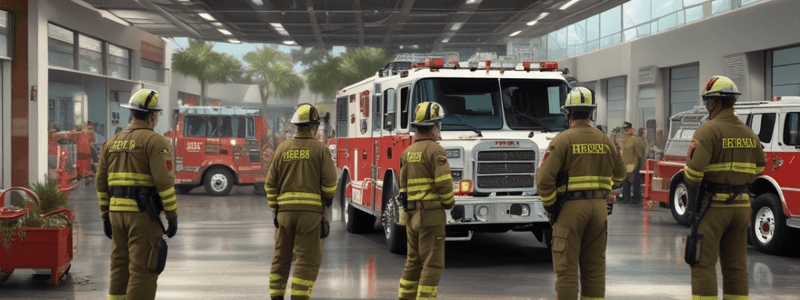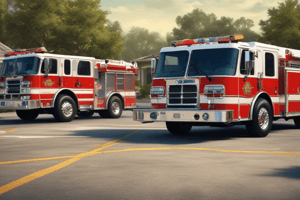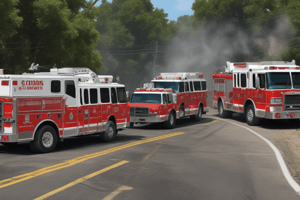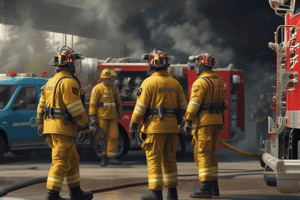Podcast
Questions and Answers
Who has the ultimate responsibility for patient care according to the policy?
Who has the ultimate responsibility for patient care according to the policy?
- Fire Rescue personnel (correct)
- On-scene health care professionals
- Fire Rescue Medical Director
- On-scene physicians
What must an on-scene physician possess to be delegated on-line control?
What must an on-scene physician possess to be delegated on-line control?
- Valid Florida licensure only
- Valid licensure to practice medicine (correct)
- Minimum of 5 years of experience
- Certification in emergency medicine
In what circumstances can the quality of patient care be improved by delegating medical control functions to on-scene physicians?
In what circumstances can the quality of patient care be improved by delegating medical control functions to on-scene physicians?
- When the Fire Rescue Medical Director is present
- In all clinical problems
- Urgent clinical situations only
- Depending on the clinical problem and expertise of the on-scene physician (correct)
Why are information cards made available for presentation to on-scene physicians?
Why are information cards made available for presentation to on-scene physicians?
Who may be delegated on-line control according to the policy?
Who may be delegated on-line control according to the policy?
What is the main purpose of promoting cooperation between St. Johns County Fire Rescue and on-scene health care professionals?
What is the main purpose of promoting cooperation between St. Johns County Fire Rescue and on-scene health care professionals?
What is required for an on-scene physician to assume on-line medical control?
What is required for an on-scene physician to assume on-line medical control?
Who has the final decision on whether an on-scene physician can assume on-line medical control?
Who has the final decision on whether an on-scene physician can assume on-line medical control?
When does a Fire Rescue Medical Director or receiving hospital emergency department physician absolve further responsibility for a patient?
When does a Fire Rescue Medical Director or receiving hospital emergency department physician absolve further responsibility for a patient?
What is the purpose of the policy regarding on-line medical control as mentioned in the text?
What is the purpose of the policy regarding on-line medical control as mentioned in the text?
Which department is the sole provider of Class A-Certificate of Public Convenience and Necessity (COPCN) prehospital EMS in St. Johns County?
Which department is the sole provider of Class A-Certificate of Public Convenience and Necessity (COPCN) prehospital EMS in St. Johns County?
How does St. Johns County Fire Rescue dispatch rescue units to incidents?
How does St. Johns County Fire Rescue dispatch rescue units to incidents?
In what situations would Fire Rescue Communications gather information regarding real or suspected trauma?
In what situations would Fire Rescue Communications gather information regarding real or suspected trauma?
What is required from Department personnel if they doubt relinquishing on-line medical control?
What is required from Department personnel if they doubt relinquishing on-line medical control?
Why might there be no relinquishing of on-line medical control according to the text?
Why might there be no relinquishing of on-line medical control according to the text?
Who can request assistance from other agencies in case of an emergency?
Who can request assistance from other agencies in case of an emergency?
Who is authorized to change the trauma alert status?
Who is authorized to change the trauma alert status?
When must a complete and accurate patient care record be available to the hospital upon request?
When must a complete and accurate patient care record be available to the hospital upon request?
What is the first step after determining that a trauma victim meets the criteria for a Trauma Alert?
What is the first step after determining that a trauma victim meets the criteria for a Trauma Alert?
What happens if ground transport time to a trauma center exceeds twenty minutes?
What happens if ground transport time to a trauma center exceeds twenty minutes?
Who will issue a trauma alert if a trauma alert patient is to be transported by ground ambulance?
Who will issue a trauma alert if a trauma alert patient is to be transported by ground ambulance?
How are pediatric trauma alert patients transported?
How are pediatric trauma alert patients transported?
When is an exception made for transporting a patient to a hospital instead of a trauma center?
When is an exception made for transporting a patient to a hospital instead of a trauma center?
Who provides information about patient care to the receiving trauma center or hospital?
Who provides information about patient care to the receiving trauma center or hospital?
What must ALS non-transporting personnel provide to transporting personnel upon transferring responsibility for a patient?
What must ALS non-transporting personnel provide to transporting personnel upon transferring responsibility for a patient?
Who notifies the air transport unit (ATU) to be enroute upon issuance of a Trauma Alert?
Who notifies the air transport unit (ATU) to be enroute upon issuance of a Trauma Alert?
What is the protocol for determining the transport destination of trauma alert patients?
What is the protocol for determining the transport destination of trauma alert patients?
What will Fire Rescue personnel do if there are deceased victims at the incident scene?
What will Fire Rescue personnel do if there are deceased victims at the incident scene?
When is a patient considered a trauma alert patient based on the criteria outlined?
When is a patient considered a trauma alert patient based on the criteria outlined?
What criteria must be met for a victim to be evaluated using the Glascow Coma Score (GCS)?
What criteria must be met for a victim to be evaluated using the Glascow Coma Score (GCS)?
Under what circumstance can an EMT or paramedic call a Trauma Alert, even if the victim does not meet the Trauma Alert criteria?
Under what circumstance can an EMT or paramedic call a Trauma Alert, even if the victim does not meet the Trauma Alert criteria?
What will be documented on the patient care report (ePCR) if the victim's condition does not meet any Trauma Alert criteria?
What will be documented on the patient care report (ePCR) if the victim's condition does not meet any Trauma Alert criteria?
What age qualifies a victim to be considered for trauma alert status based on the provided criteria?
What age qualifies a victim to be considered for trauma alert status based on the provided criteria?
Which of the following conditions would NOT classify a victim as a trauma alert patient?
Which of the following conditions would NOT classify a victim as a trauma alert patient?
When would a victim be considered a trauma alert patient based on airway assistance needs?
When would a victim be considered a trauma alert patient based on airway assistance needs?
What is one of the signs that would qualify as an indication for calling a Trauma Alert?
What is one of the signs that would qualify as an indication for calling a Trauma Alert?
What is the primary responsibility of law enforcement regarding the landing zone (LZ)?
What is the primary responsibility of law enforcement regarding the landing zone (LZ)?
What should be done if unforeseen circumstances arise during the ATU's final approach, making landing unsafe?
What should be done if unforeseen circumstances arise during the ATU's final approach, making landing unsafe?
What are the minimum requirements for the size and condition of the landing zone (LZ)?
What are the minimum requirements for the size and condition of the landing zone (LZ)?
What should be done if the LZ is located in a sandy area?
What should be done if the LZ is located in a sandy area?
How should the LZ be illuminated at night?
How should the LZ be illuminated at night?
What should the ground guide do on the initial ATU approach?
What should the ground guide do on the initial ATU approach?
What should the ground guide do once the ATU is on final approach?
What should the ground guide do once the ATU is on final approach?
What should the ground guide do if the landing is conducted at night or in decreased visibility?
What should the ground guide do if the landing is conducted at night or in decreased visibility?
What is the responsibility of law enforcement personnel after the ATU has landed?
What is the responsibility of law enforcement personnel after the ATU has landed?
What should the ground guide do after the patient is loaded and the ATU lifts off?
What should the ground guide do after the patient is loaded and the ATU lifts off?
Which of the following is not considered a criteria for a Trauma Alert?
Which of the following is not considered a criteria for a Trauma Alert?
What is the systolic blood pressure threshold for a Trauma Alert under the Circulation criteria?
What is the systolic blood pressure threshold for a Trauma Alert under the Circulation criteria?
Which of the following is not considered a component for determining a Trauma Alert based on 2 or more criteria?
Which of the following is not considered a component for determining a Trauma Alert based on 2 or more criteria?
What is the weight threshold for a Trauma Alert under the Size criteria?
What is the weight threshold for a Trauma Alert under the Size criteria?
What is the length threshold for a Trauma Alert under the Size criteria?
What is the length threshold for a Trauma Alert under the Size criteria?
Under what circumstances can an EMT or Paramedic call a Trauma Alert if the patient does not meet the stated criteria?
Under what circumstances can an EMT or Paramedic call a Trauma Alert if the patient does not meet the stated criteria?
Which information is the referring hospital required to provide to the transporting unit when arranging an emergency interhospital transfer?
Which information is the referring hospital required to provide to the transporting unit when arranging an emergency interhospital transfer?
Which hospital is not considered a designated Receiving Hospital utilized by St. Johns County Fire Rescue?
Which hospital is not considered a designated Receiving Hospital utilized by St. Johns County Fire Rescue?
What is the first step in the Decision Tree for determining if a patient meets 'Trauma Alert' criteria?
What is the first step in the Decision Tree for determining if a patient meets 'Trauma Alert' criteria?
What is the required documentation if there is a deviation from the Trauma Transport Protocols?
What is the required documentation if there is a deviation from the Trauma Transport Protocols?
What is the primary purpose of this policy?
What is the primary purpose of this policy?
Which of the following is NOT information that Fire Rescue Communications will request when an ATU is needed?
Which of the following is NOT information that Fire Rescue Communications will request when an ATU is needed?
What is the responsibility of the Patrol Shift Leader when an ATU is requested?
What is the responsibility of the Patrol Shift Leader when an ATU is requested?
Who maintains final authority for all decisions relating to ATU transport?
Who maintains final authority for all decisions relating to ATU transport?
What is the responsibility of the Landing Zone Supervisor?
What is the responsibility of the Landing Zone Supervisor?
When is a second helicopter considered for transport?
When is a second helicopter considered for transport?
What is the primary responsibility of law enforcement in the ATU landing process?
What is the primary responsibility of law enforcement in the ATU landing process?
Who is responsible for communicating with the ATU during the landing process?
Who is responsible for communicating with the ATU during the landing process?
What is the default location for the ATU to land initially?
What is the default location for the ATU to land initially?
What is the purpose of notifying the Patrol Shift Leader and Watch Commander of an ATU request?
What is the purpose of notifying the Patrol Shift Leader and Watch Commander of an ATU request?
Flashcards are hidden until you start studying
Study Notes
St. Johns County Fire Rescue Policy
- Purpose: Promote cooperation between Fire Rescue and on-scene healthcare professionals to ensure efficient and respectful patient care.
- Scope: Applies to Fire Rescue personnel responsible for patient care decisions.
On-Scene Physicians
- Delegating medical control to on-scene physicians may improve patient care, but they must accept full responsibility and possess valid Florida licensure.
- Requests for ID and proof of licensure may be made on a selective basis.
- On-scene physicians must accompany the patient to the hospital and assume full and continuous care until arrival.
Liability
- Fire Rescue Medical Director or receiving hospital emergency department physician is responsible for delegating on-line medical control.
- No on-scene physician has the right to assume on-line medical control without express permission.
- Liability is absolved once the patient arrives at the receiving hospital.
Trauma Transport Policy
- Purpose: Ensure patients with traumatic injuries are efficiently evaluated and transported to the most appropriate facility.
- Scope: Applies to all career employees of St. Johns County Fire Rescue who make decisions related to trauma transport.
Service Description
- St. Johns County Fire Rescue is a licensed advanced life support provider of prehospital emergency care.
- It is the sole provider of Class A-Certificate of Public Convenience and Necessity (COPCN) prehospital EMS in St. Johns County.
Receiving and Dispatching Calls
- Fire Rescue Communications gathers information from individuals requesting emergency medical assistance, including number of victims, incident location, type of incident, and patient information.
- Rescue units are dispatched based on location and response zones.
Prehospital Procedures
- EMTs and Paramedics assess patients using the Adult or Pediatric Trauma Scorecard Methodology.
- Transport destination is determined by the assessment.
- Patients are evaluated using the Glascow Coma Score (GCS) if they do not meet Trauma Alert criteria.
Trauma Alert Criteria
- Adult Trauma Alert criteria:
- Severity of injury measures (airway, circulation, Best Motor Response, cutaneous, long bone fracture)
- Mechanism of injury (e.g., ejection from a motor vehicle, fall from 10 feet or greater)
- Age (55 years or older)
- Pediatric Trauma Alert criteria:
- Severity of injury measurements (airway, consciousness, circulation, fracture, cutaneous)
- Size (11 kg or less, or length of 33 inches or less)
Transport Methods
- Patients who meet Trauma Alert criteria are considered for transport by Air Transport Unit (ATU) first.
- If ATU is unavailable, patients are transported by ground unit to the approved trauma center nearest the incident location.
- Exceptions include deteriorating patient condition, ground transport time exceeding 20 minutes, or unavailability of ATU.
Hospital List
- Designated State approved trauma centers, pediatric trauma referral centers, and receiving hospitals:
- State Approved Trauma Center (SATC): Shands-Jacksonville, Jacksonville Orange Park Medical Center
- State Approved Pediatric Trauma Referral Center (SAPTRC): Shands-Jacksonville, Jacksonville
- Receiving hospitals: Flagler Hospital, St. Augustine Baptist Medical Center, etc.
Protocol Deviation
- Any deviation from these protocols must be fully documented and justified on the ePCR.### Adult Criteria
- Airway control is a priority over O2
- Red flags for airway control: • Paralysis • Amputation proximal to wrist or ankle • HR 120 or higher
- Red flags for circulation: • Lack of radial pulse • HR 120 or higher • Suspicion of spinal cord injury • Penetrating injury to head, neck, or torso • BMR 5 or less
- Red flags for respiration: • Respiratory rate 30 or higher • GCS 12 or less
- Red flags for burns: • 2nd or 3rd degree burns 15% or more of total body surface area
- Red flags for miscellaneous: • Age 55 or older • Ejection from a motor vehicle • Multiple long bone fractures • Major degloving injury
Pediatric Criteria
- Red flags for airway: • Intubated or maintained by adjuncts • Loss of sensation • Multiple dislocations • Amputations proximal to wrist and ankle • Systolic B/P under 90mmHg
- Red flags for circulation: • Faint or non-palpable radial or femoral pulse • Systolic B/P under 50mmHg • Major degloving • Multiple fracture sites • 2nd or 3rd degree burns 10% or more of total body surface area
- Red flags for respiration: • Comatose • Loss of consciousness • Weight under 11kg • Pediatric length under 33 inches
- Red flags for miscellaneous: • Paralysis • Evidence of open long bone fracture • Major flap avulsion
Air Transport Unit (ATU) Policy
- Purpose: Establish policy for safe and efficient use of ATU
- Scope: All Fire Rescue personnel responsible for ATU utilization
- Determination: Based on airway, circulation, respiration, and miscellaneous criteria
Landing Zone (LZ) Procedure
- LZ must be 100’ x 100’ area clear and free from obstructions
- Level ground with no more than a 10-degree slope, preferably paved or grassy
- Pilot will be informed of hazards such as trees, power lines, etc.
- At night, lights should be placed at each corner of the LZ, shining across the LZ
- LZ should be located at least 100’ from rescue staging area
- Ground guide will always wear eye protection
- No hats, caps, or other headgear not attached to the head are to be worn in or near LZ
ATU Landing
- Once radio contact is established, only the LZ supervisor should communicate with ATU
- LZ supervisor will describe the LZ to the pilot, including location, landmarks, hazards, wires, vehicles, and other obstacles
- If ATU is to land on a highway, the LZ supervisor will stop traffic in time to give ATU ample space and time to observe area and make landing decision
- In most cases, ATU will circle LZ at least once to observe and communicate with the ground guide
- The pilot has the final decision on whether to land or not
- On initial ATU approach, the ground guide should face the LZ with arms extended upward and palms facing LZ
- Once ground guide makes eye contact with ATU personnel, they should move away from the LZ to avoid rotor wash
Helicopter Safety
- Remain clear unless accompanied by an ATU crewmember
- Do not assist ATU crew in opening or closing doors
- No unauthorized persons within 100’ of the aircraft
- No smoking near the aircraft
- Never approach ATU from the rear
- After ATU lands, law enforcement personnel will be responsible for safety and security of the LZ while patient is being loaded onto the aircraft
Studying That Suits You
Use AI to generate personalized quizzes and flashcards to suit your learning preferences.




